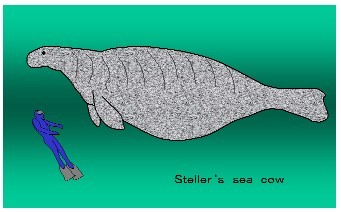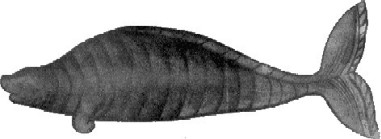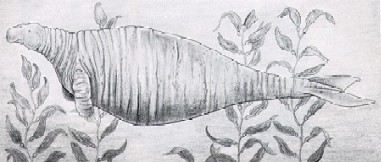Steller’s Sea Cow Sighting?
Posted by: Loren Coleman on September 16th, 2006
This old print of the Steller’s Sea Cow may be made full-size by clicking it.
Could an animal that supposedly went extinct in 1768 still be in the waters of the Pacific?
Sirenians are vegetation-eating mammals, which have completely adapted to living in water. In the fossil record, there is evidence of more than a dozen species, but today Sirenia consists of just four species–the West Indian Manatee (Trichechus manatus), the Amazon Manatee (Trichechus inunguis), the West African Manatee (Trichechus senegalensis), and the Dugong (Dugong dugon)–and two subspecies, the Florida manatee (Trichechus manatus latirostris) and the Antillean manatees (Trichechus manatus manatus), both subspecies to the West Indian. These are found in both marine and freshwater, though the Amazon manatee is an exclusively freshwater creature and the dugongs seem to be exclusively marine. Sirenians are commonly referred to as “sea cows,” even though only the supposedly extinct Steller’s Sea Cow (Hydramalis gigas stelleri) should perhaps be called a “cow of the seas.”
The existence of the Steller’s Sea Cow dates back to the Pleistocene, when it ranged the Pacific from Japan to Baja, California. It was first discovered and described for science in 1741 by German naturalist Georg Wilhelm Steller during explorer Vitus Bering’s expedition to the sea that now bears his name. At that time a population of about two thousand lived in the shallow coastal waters of the north Pacific. These large, rotund animals traveled in herds of males, females, and juveniles, and were said to be gregarious and, for their sake, far too friendly to humans.
Soon after their discovery, fur hunters began to kill the defenseless Steller’s Sea Cow for its tasty meat, and within 27 years, the Steller’s Sea Cow had been systematically slaughtered to extinction. The last Steller’s Sea Cow supposedly died on one of the Bering Islands in 1768.
Where the story of the zoological Steller’s Sea Cow ends, however, the story of the cryptozoological Steller’s Sea Cow begins, as sightings of these animals have continued, off and on, for the last 200 years. Residents of Bering Island claimed that Sea Cows were still being killed and eaten in the area in the late 1770s. A Polish naturalist was certain that Sea Cows had survived on Bering Island as late as 1830 and native reports of the animal were recorded there and in the Aleutian Islands in the mid-19th century.
The above is a selection of passages from The Field Guide to Lake Monsters, Sea Serpents, and Other Mystery Denizens of the Deep. The field guide also details recent encounters with Steller’s Sea Cows.
A Steller’s Sea Cow allegedly washed up on the shores of Cape Chaplin, on the northern end of the Gulf of Anadyr, Siberia, in 1910. In the middle of the century, a harpooner reported regularly seeing 32-foot, finless animals not far from Bering Island in July of every year. The crew of a Russian whaler observed a group of what appear to be Sea Cows in 1962 (see the field guide for a detailed discussion of this sighting), and Russian fisherman walked up to—and touched—a live Sea Cow at Anapkinskaya Bay in the summer of 1976, though this may have been a stray Northern elephant seal. And finally, a Sea Cow skeleton was supposedly found on a Soviet island in 1983.
Now comes a new 2006 report from off Washington State, which might be added to the legacy of the Steller’s Sea Cow.

Writing in an “A manatee, off our coast?” in the Chinook Observer of Long Beach, Washington State, September 13, 2006, Captain Ron Malast writes:
There have some unusual sightings and catches along the Washington Coast this summer, but none more bizarre than the sighting of a manatee. While trolling for tuna on a course parallel to the Big Dipper, at about 40 miles off the coast, I received a radio call from a skipper of another charter boat. The skipper, for whom I have great respect as a fisherman and a straight shooter, wishes to remain anonymous for fear of being put in a straight-jacket and sent to a loony bin.
He said, “Did you see that? It was a manatee. It was bigger than a sea lion and about 12 feet long. At first I did not know what it was, but we cruised closer to it and I looked it straight in the eye. I then knew exactly what it was, it stayed on the surface for about two minutes, unafraid and then slipped off into the deep. When my brother, who was also on the charter boat, and I got home, we immediately got on the computer and pulled up a picture of a manatee and it was the same mammal that we had seen that afternoon. I will remember it to my dying day for what it was – a manatee.”
Zoologist Bernard Heuvelmans was one of the first to recognize the fact that Steller’s Sea Cow may not be extinct. More recently mainstream scientists, as cited in the field guide, such as marine biologists Bret Weinstein and James Patton of the University of California have noted that there are vague reports of Steller’s Sea Cows from along the northwest coast of North America and the northeast coast of Asia, in the Arctic Ocean and Greenland. If such reports are not discounted, then Hydramalis gigas stelleri, or a subspecies, may still be alive today.
Click image for full-size version
About Loren Coleman
Loren Coleman is one of the world’s leading cryptozoologists, some say “the” leading living cryptozoologist. Certainly, he is acknowledged as the current living American researcher and writer who has most popularized cryptozoology in the late 20th and early 21st centuries.
Starting his fieldwork and investigations in 1960, after traveling and trekking extensively in pursuit of cryptozoological mysteries, Coleman began writing to share his experiences in 1969. An honorary member of Ivan T. Sanderson’s Society for the Investigation of the Unexplained in the 1970s, Coleman has been bestowed with similar honorary memberships of the North Idaho College Cryptozoology Club in 1983, and in subsequent years, that of the British Columbia Scientific Cryptozoology Club, CryptoSafari International, and other international organizations. He was also a Life Member and Benefactor of the International Society of Cryptozoology (now-defunct).
Loren Coleman’s daily blog, as a member of the Cryptomundo Team, served as an ongoing avenue of communication for the ever-growing body of cryptozoo news from 2005 through 2013. He returned as an infrequent contributor beginning Halloween week of 2015.
Coleman is the founder in 2003, and current director of the International Cryptozoology Museum in Portland, Maine.












The ocean is a big place. There could have been a population of Steller’s Sea Cow, unknown to people, which survived the slaughter. But sirenians reproduce slowly, so it would take time for the population to increase. Who knows? I think it’s possible that some have survived. Maybe the warming of the Arctic is causing them to venture further from their original habitat.
Loren
I notice the times of your posts.
Do you EVER sleep? 😉
Man, those are a lot bigger than I thought they were. With the poles melting, it doesn’t seem unrealistic that we’re going to see some things we didn’t know were out there.
Is this Steller the same zoologist for which the beautiful Steller’s Jay is named?
This is a wonderful find! I have no problem believing that the Stellars Sea Cow could still be existing in the North Pacific. This warrants further investigation. Hopefully this sighting will be verified sometime soon.
“Maybe the warming of the Arctic is causing them to venture further from their original habitat.”
Actually, iirc Steller’s Sea Cow originally was found along most of the west coast of North America, but they were hunted out sometime after the arrival of humans in North America.
This is something I have suspected and hoped for since I was a child. I would love nothing more than to hear confirmation that Stellar’s sea cows had been rediscovered and that some conservation efforts were being fast-tracked.
Who knows, perhaps some of the ‘Cadborosaurus’ remains that have been found over the past century will have actually been decomposed sea cow carcasses.
Stellar gave his name to both Stellar’s Jay and Stellar’s Sea Lion. He was also the first and (so far as I know) only witness to a cryptid known as Stellar’s Sea Ape.
“These large, rotund animals… were said to be gregarious and, for their sake, far too friendly to humans.”
What a terrible shame. It seems these creatures saw something in us that was worth exploring more closely. And in return we wiped them out (or if the reports in this article are true at the very least we made a good effort of it)
I’d like to think something like this wouldn’t happen if a new animal of this calibre were discovered in modern times (like a Bigfoot or Mokele) but my cynicism for human nature tells me better.
I hope the sea cow is still with us, but I would not put a lot of chips on this crypto-bet. The animal was huge, air-breathing, preferred shallow water, and, as I noted in Rumors of Existence, was “about as mobile and as easily overlooked as a derelict ship.” I wonder about a wandering female walrus or elephant seal as the source of this report.
Now how big could (or can) they get?
Howdy,
I’ve often had similar thoughts, I’d love to find out that there had been some group of the stellers sea cows living in isolated islands somewhere far from people. Eventually, they’d be rediscovered and bred out to repopulate their old stomping (and splashing) grounds. I don’t think it is outside the realm of possibilities.
As far as them being (re)hunted to (re)extinction by people. I doubt we’d have to worry about that these days. Remember back then people ate ANYTHING just to survive. Most of human society was right on the edge of starvation from birth to death. People in my part of the country were even eating manatees back during the great depression because their families were starving. Manatees were also at the brink of extinction at one point but have been coming back strong and can be seen all over the state of Florida.
As a side note, they certainly are fun and will swim right up to you and roll on their backs so you can rub the itchy algea off their bellies.
I hope to hear more “Stellers” sightings. hope hope hope.
–jeff
According to “A Gap In Nature” by Tim Flannery and Peter Schouten (Excellent book that I recommend to all, by the way), the females may have reached lengths of 8 meters and weighed as much as 10 tons.
Steller is also noted for the discovery of Steller’s Sea Eagle,the sighting of something that may or may not have been an Albatross, and Steller’s Sea Ape, which remains unrecognized by science. Here’s a brief description I jotted down some time ago-
A 5-foot-long sea-going mammal reliably reported by noted naturalist Georg Wilhelm Steller in 1741. He viewed it for 2 hours and described it as having a dog-like head with pointed, erect ears, a whiskered face, and large eyes. Its body was covered in thick fur, grey on the back but reddish-white on the belly of its round tapered body that ended in a shark-like tail and was otherwise devoid of either fins or forelimbs. When he tried to shoot it it fled, and was not seen again until the middle of last century.
brineblank: To be truly available to the science of cryptozoology, one must be available 24/7 to jump in the cryptomobile, collect evidence, and hurry back before dawn to write another blog. 🙂
I do get up very early and stay up very late quite often, but since the times recorded apparently are Central times and I live in the Eastern zone, they often may be an hour earlier than when I write them, unless there is a reason (due to the change of days) for a techie to forward them to the future. But the site will not take times before they happen, although it might be tomorrow in Malaysia for a blog that is really written yesterday, if you know what I mean.
;-}
“It seems these creatures saw something in us that was worth exploring more closely.”
In other words, they saw something that wasn’t there!
“Russian fisherman walked up to—and touched—a live Sea Cow at Anapkinskaya Bay in the summer of 1976, though this may have been a stray Northern elephant seal.”
Y’know, there’s just that certain je nais ce qua that makes me doubt anyone could walk up and touch an elephant seal and live to tell about it.
Maybe it was a sick seal? We get sick harbour seals and whatnot here in NJ, and often they can be approached with no problem, even though healthy ones are quite capable of biting off fingers…admittedly elephant seals are much bigger and better known for their aggressive tendencies, but if Steller Sea Cows are completely marine and weigh so much, wouldn’t any Cow stuck on a beach not be alive for very long?
SEA cow…humm.. sightings off the coast of Vancouver island for many years of a strange large creature with hump and dog like head with wiskers.
hummm.. could this be it??
I AM THINKIN could be IT…
I think Trapster has it that remote islands in the Pacific may yet harbour sea cows – although it’s unlikely.
However, even today humans are hunting and eating endangered whales amongst other things. I disagree that we’d automatically care for this critter to the point of saving it if it’s there.
I wonder if some Canadian and NW US lake monsters might be Steller’s Sea Cow? I’ve often suspected Ogopogo to be an undiscovered whale, maybe the Sea Cow is just as valid a candidate.
“I wonder about a wandering female walrus or elephant seal as the source of this report.”
On the other hand, I wonder how many sightings of sea cows may have been passed off as just another walrus or elephant seal.
The article mentioned possible sightings around Greenland and (an)unspecified area(s) of the Arctic Ocean. To the best of my knowledge, the Steller’s Sea Cow has officially only ever been recorded from the North Pacific. It would really be interesting to find them in other northerly waters as well.
“I wonder if some Canadian and NW US lake monsters might be Steller’s Sea Cow?” Do these lakes have outlets to the ocean. At 30 feet long, these critters would need a lot of food. A land-locked lake probably couldn’t support a viable population for very long unless it had a lot of shallow areas suitable for growing water plants. Also, the farther north a lake is, the more prone it is to freezing over in the winter. A 30 foot animal could probably force its way through maybe 6 inches of ice to breath, but more than that would probably be too difficult. Have there been any reports of frozen over lakes having inexplicable breaks in the ice?
A stellar sea cow is the solution to lake cryptids and sea cryptids i disagree, who really knows what survived and didnt survive in the day of the dino era. The oceans hide many mysteries and at the present time the oceans and lakes are not going to give up their mysteries.
Well actually randz I said -some- lake monster sightings. So to say that it is -the- solution would be a mistake and I would never make such a blanket comment. Just like I would not say that all lake monsters are holdovers from the dinosaur age. I’d love them to all be living dragons as much as the next person but I don’t see how a large reptilian could survive in the frigid lakes of Canada. I suppose it’s possible… turtles and snakes do it but they are nowhere near the size we are speaking of here